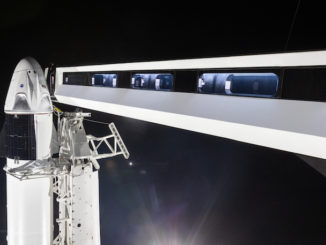
Sensors delivered to Mars by NASA’s InSight lander have detected the first signals suggesting seismic activity on the red planet, a major discovery that extends the field of seismology to a new world beyond the Earth and the moon.
Scientists announced the detection Tuesday, characterizing the seismic signal as the first “likely” indication of a “marsquake.”
InSight’s Seismic Experiment for Interior Structure, or SEIS, instrument detected the faint signal April 6. Scientists said the shaking appears to have originated inside the planet, rather than from wind or mechanical disturbances from the InSight spacecraft itself.
“We’ve been waiting months for a signal like this,” said Philippe Lognonné, SEIS team lead at the Institut de Physique du Globe de Paris (IPGP) in France. “It’s so exciting to finally have proof that Mars is still seismically active. We’re looking forward to sharing detailed results once we’ve had a chance to analyze them.”
Rather than the movement of tectonic plates, which generates quakes on Earth, scientists believe Martian tremors are generated by the cooling and contraction of the planet. Over time, the contraction builds up stress until it is strong enough to break the crust, causing a quake, according to InSight scientists.
Researchers are still studying the seismic data to determine the cause of the signal, which was too weak to provide useful data on the structure of the interior of Mars, one of the $1 billion InSight mission’s primary objectives, scientists said.
NASA’s Jet Propulsion Laboratory, where the InSight mission is managed and controlled, released an audio and video recording of the April 6 event illustrating the vibrations detected by the seismometer instrument. Before and after the suspected marsquake, the seismic sensors registered shaking caused by Martian winds and movement of the InSight lander’s robotic arm.
The faint signal would likely have escaped detection on Earth, according to CNES, the French space agency, which funded development of the SEIS instrument.
The extremely sensitive seismometers delivered to Mars by the InSight mission were placed directly on the Martian surface by the spacecraft’s robotic arm in December, several weeks after its Nov. 26 landing on the red planet.
The seismic sensors are installed inside a vacuum enclosure nested within several layers of protective shielding. The outermost layer is a wind and thermal shield, which InSight’s robotic arm placed over the instrument earlier this year.
The April 6 event fits the profile of moonquakes detected by seismometers left on the lunar surface by the Apollo astronauts, scientists said.
“InSight’s first readings carry on the science that began with NASA’s Apollo missions,” said Bruce Banerdt, InSight’s principal investigator at JPL, in a statement. “We’ve been collecting background noise up until now, but this first event officially kicks off a new field: Martian seismology!”
The seismometer also detected even fainter seismic signals on March 14, April 10 and April 11, which could be caused by seismic activity within the red planet.
“Earth is no longer the only planet continuously monitored by seismometers,” said Antoine Petit, CEO of CNRS, the French Center for National Research. “The SEIS instrument deployed on Mars at the start of this year is now recording the slightest ground vibrations day and night, be they due to the atmosphere and its winds sweeping the surface or to quakes and meteorite impacts.
“Mars is thus the third rocky planetary body in the solar system to be studied by seismologists, 130 years after the beginnings of instrumental seismology on Earth and 50 years after the first seismometer deployed by Apollo 11 in July 1969,” Petit said.
The seismometer instrument is one of three primary science experiments on the InSight mission.
The lander deployed a German-built mole in February to begin digging into the Martian surface. Designed to measure heat and thermal conductivity to a depth of up to 16 feet (5 meters), the underground science probe stalled reaching a depth of about one foot (30 centimeters).
Engineers continue studying the cause and possible remedies for the problem. While ground teams initially considered it likely the heat probe hit a rock, another possibility is that the mole may not be encountering enough friction, or resistance, in the soil to keep it from recoiling with each hammer stroke.
Part of the mole or its umbilical tether may also be snagged in the instrument’s support structure, which sits on the surface.
The Heat and Physical Properties Package, or HP3, instrument is designed to probe deeper into the Martian surface than any previous mission, and gather data on underground temperatures at varying depths, giving scientists a clearer understanding of the amount of heat escaping the planet’s interior.
A third major science investigation on the InSight mission is the Rotation and Interior Structure Experiment, or RISE, which will use radio signals passed between the lander and Earth to measure the wobble of Mars’s rotation, giving scientists an idea of the Red Planet’s core size and density.
Email the author.
Follow Stephen Clark on Twitter: @StephenClark1.



